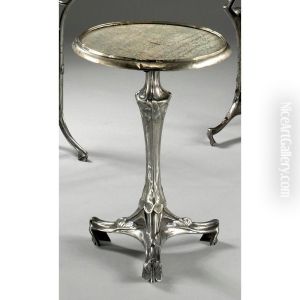Hector Guimard Paintings
Hector Guimard was a prominent French architect and designer, best known for his significant contribution to the Art Nouveau movement. Born on March 10, 1867, in Lyon, France, Guimard moved to Paris at a young age, where he later studied at the École nationale supérieure des arts décoratifs and the École des Beaux-Arts. He was deeply influenced by the works of Victor Horta, a Belgian architect, which is evident in his designs that incorporate organic forms and natural motifs.
Guimard's career took a decisive turn in 1898 when he was commissioned to design the entrances for the new Paris Métro system. His innovative use of wrought iron and glass, along with the distinctive, flowing lines and organic shapes, became iconic symbols of the Art Nouveau movement. These Métro entrances are celebrated for their elegance and functional design, seamlessly blending art with industrial materials.
Beyond the Métro stations, Guimard's work includes a range of buildings and decorative art pieces, including furniture, glassware, and ceramics. Among his notable architectural works are the Castel Béranger, Hotel Guimard, and the Coilliot House. His approach often integrated the structure with its decoration, blurring the lines between architectural and decorative arts. Despite his success, the rise of Art Deco and changing tastes led to a decline in Guimard's popularity by the time of his death on May 20, 1942, in New York City, where he had moved during World War II to escape the Nazi occupation of France.
Guimard's legacy, however, has endured, and he is now celebrated as a visionary who played a crucial role in the development of modern design. His works are seen not only as masterpieces of Art Nouveau but also as precursors to the modernist movement in architecture. Guimard's emphasis on organic forms, integration of functional objects with artistic design, and innovative use of new materials continue to influence designers and architects to this day.
